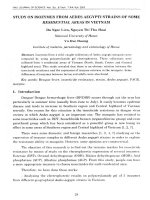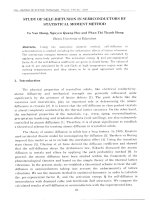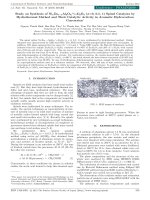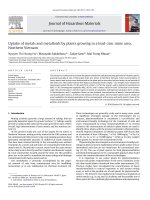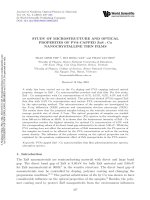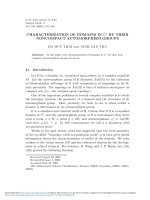DSpace at VNU: Study of self-diffusion in semiconductors by statistical moment method
Bạn đang xem bản rút gọn của tài liệu. Xem và tải ngay bản đầy đủ của tài liệu tại đây (291.58 KB, 8 trang )
VNU. JOURNAL OF SCIENCE, Mathematics - Physics, T .xx, N01 - 2004
STUDY OF SELF-DIFFUSION IN SEMICONDUCTORS BY
STATISTICAL MOMENT METHOD
Vu Van H ung, N g u y en Q uan g Hoc and P h a n Thi T h an h H ong
Hanoi Un iversity o f Education
Abstracts. Using the statistical moment method, self-diffusion in
semiconductors is studied including the anharmonic effects of lattice vibrations.
The interaction energies between atoms in semiconductors are estimated by
applying many-body potential. The activation energy Q and pre-exponential
factor D{) of the self-diffusion coefficient are given in closed forms. The values of
Q and D0 are calculated for Si and GaAs at high temperature region near the
melting temperatures and they shown to be in good agreement with the
experimental data
1. I n t r o d u c tio n
The physical properties of crystalline solids, like electrical conductivity,
atomic diffusivity and mechanical stre n g th are generally influenced quite
significantly by the presence of lattice defects [1]. The point defects like the
vacancies and in te rstitials, play an im portant role in determ ining the atomic
diffusions in crystals [2]. It is known th a t the self-diffusion in close-packed crystals
is alm ost completely conducted by the therm al lattice vacancies. On the other hand,
the mechanical properties of the m aterials, e.g., creep, aging, recrystallization,
precipitation h a rd e n in g and irradiation effects (void swelling), are also extensively
controlled by atomic diffusions [ 1J. Therefore, it is of great significance to establish
a theoretical scheme for tre a tin g atomic diffusion in crystalline solids.
The theory of atomic diffusion in solids has a long history. In 1905, Einstein
used incidental chaotic model for investigating the diffusion [3]. Bardeen và Hering
impoved this model so as to include the correlation effect [4]. Using the transition
state theory [5], Glestom et al. have derived the diffusion coefficient and showed
th a t the self-diffusion obeys the A rrhen ius’s law. Kikuchi discussed the atomic
diffusion in m etals and alloys by applying the path probability method [6 ]. In
general the atomic diffusion have been studied w ithin the fram ework of the
phenomenological theories and based on the simple theory of the th erm al lattice
vibrations. In the p resen t study, we establish a theoretical scheme to tr e a t the self
diffusion in sem iconductors tak in g into account the anharm onicity of lattice
vibrations. We use the m om ent method in statistical dynam ics in order to calculate
the pre-exponential factor D 0 and the activation energy Q for self-diffusion in
semicoductor with diam ond cubic and zincblende ZnS stru c tu re s. We compare the
calculated resu lts of self-diffusion in semiconductors with the experim ental data.
24
Vu Van Hung , Nguyen Quang Hoc , Phan Thi Thanh Hong
2. T h e o r y o f s e lf-d iffu s io n in s e m e c o n d u c t o r s
In the case of the self-diffusion conducted by a vacancy mechanism, it has
been generally assum ed th a t the diffusion coefficient D is simply given as
D = av exp [- Q/ RT)], Q = gvf + gvm,
(1)
where a and V are the jum p distance and a tte m p t frequency of the atom,
respectively. The activation energy Q of the self-diffusion is the sum of the changes
in the free energy for the form ation gvf and m igration gvmof the vacancy.
In this paper, we investigate the self-diffusion in sem iconductors by using the
moment method in sta tistica l dynamics. We consider the self-diffusion via vacancy
mechanism and do not take into account the contribution from di-vacancies and
direct atomic exchange m echanism s. We take into account the global lattice
expansion originated from the anharm onicity of th erm al lasttice vibrations, but do
not co n sid er th e d e ta ile d local la ttic e re la x a tio n aro u n d th e vacancies. In o rd e r to
study the atomic diffusion in semiconductors, one m ust firstly determ ine the
equilibrium lattice spacing and the free energy of the perfect crystal because the
atomic diffusion occur at finite tem p eratu res. The calculational procedure for
obtaining therm odynam ic q u an tities of the perfect crystals has been given in our
previous studies [7,8]. We then derive the therm odynam ic q u an tities of the crystal
containing th erm al lattice vacancies, which play a central role in the self-diffusion
of semiconductors.
Let us consider a monoatomic crystal consisting of N atom s and n lattice
vacancies. By assum ing N » n the Gibbs free energy of the crystal is given as
G(T, p) = Go(T,p) + n gvf(T,p) - T SC,
(2 )
where T and p denote the absolute tem p e ra tu re and hydrostatic pressure,
respectively. G 0(T,p) is the Gibbs free energy of pefect crystal of N atoms, gvf(T,p) is
the change in the Gibbs free energy due to the form ation of a single vacancy and s c
is the entropy of mixing
c _ 1 1 (N + n)!
Sc = k Bln ~T,'
N!n!
where k B denotes th e B oltzm ann constant. It is noted here th a t gvf(T,p) contains
contribution from vibrational entropy of the system.
The equilibrium cocentration of a vacancy n v in semiconductors can be
calculate from the Gibbs free energy of the system. To obtain the equilibrium
concentration nv, we use the m inim ization condition of the free energy with respect
to nv und er the condition of constant p, T and N as
(ỠG/ <9nv)p T N = 0 .
(4)
Study of self-diffusion in semiconductor by.
25
This m inim ization condition leads to the concentration of the vacancy as
nv = exp
g fv (T,p)!
e
(5)
with 0 = k BT. Then, the Gibbs free energy of the crystal containing equilibrium
therm al vacancies can be given by
g j = - (n, + n 2) V|I0" + 11, 1)/!* + n 2i|/2* + Aụ0\
(6 )
where
V|V = 3{U0/ 6 + 0[x + In (1 - e ■2x)]},
(7a)
u 0 = I (Poi ( lr, I),
(7b)
r, = r 0 + A r,.
(7c)
H ere, X = ỈKÙỈ 20, CO d en o tes th e atom ic v ib ra tio n a l freq u en cy , n, a n d n 2 denote
num bers of the first and second nearest-neighbours, respectively. i|/0* = \ụ0l N
denotes the Helmholtz free energy per single atom in the perfect crystal[ 6 ],vị/j and
vị/2* rep re se n t the free energy of the atoms located at the nearest-n eigh bou r and next
n e a re st-n e ig h b o u r s ite s of th e vacancy, resp ectiv ely , cpoi is th e in te ra c tio n energy
between zeroth and i-th atoms, r, indicates the position of th e i-th atom located at
the neighbouring sites of the central 0 -th atom or the n e a re s t distance of the i-th
atom a t te m p e ra tu re T, r 0 determ ines the n e arest distance of the i-th atom at
te m p e ra tu re OK, Ar, indicates the displacem ent of the i-th atom from the
equilibrium position at te m p e ra tu re T or the th erm al expansion depending on
te m p e ra tu re of lattice and it is determ ined as in [9]. It m u st be noted th a t we take
into account the an harm onicity of the therm al lattice vibration and therefore the
te m p e ra tu re dependent th erm al lattice expansion and vibrational force constants
are considered.
To calculate the interaction energy U() of the perfect crystal, we use the
em pirical pair potentials and take into account the contributions up to the second
nearest-neighbours. AVỊ/0‘ denotes the change in the Helmholtz free energy of the
central atom which creates a vacancy by moving itself to the certain sinks ( e.g.,
crystal surface, or to the core region of the dislocation and grain boundary) in the
crystal
= v|/0*’ - Vị/q* = (B - 1) ụ 0* ,
(8)
where v|/0*' denotes the free energy of the central atom after moving to a certain sink
sites in the crystal. In this respect, it is noted th a t the vacancy form ation energies
Vu Van Hung, Nguyen Quang Hoc, Phan Thi Thanh Hong
26
of the real crystals are m easured experim entally as an average value over all those
values corresponding to the possible sink sites.
In the theoretical analysis, it has been often assum ed t h a t the central atom
originally located at the "vacancy site" moves to the special atom ic sites, i.e., k in k
sites on the surface or in the core region of the edge dislocation in the bulk crystal
which are therm odynam ically eqivalent to bulk atoms [10]. This assum ptio n simply
leads to B = 1 in the above eq. (8 ). In the present study, we take the average value
for B as
c
1 t - ( l + n, + n 2)vồ + n i\y] + n 2v|/2
~2
This
recovered
around a
relaxation
especially
- 2 v|/J
is equivalent to the condition th a t the h alf of the broken bonds are
at the sink sites. We do not take into account the lattice relaxation
vacancy, because the change in the free energy due to the lattice
is a minor contribution compared to the form ation energy of a vacancy,
for high te m p e ra tu re region near the m elting te m p e ra tu re .
We now derive the therm odynam ic quantities of th e semiconductor lattice
containing th erm al vacancies and discuss the self-diffusion via vacancy mechanism.
From (2), the Gibbs free energy of the semiconductor lattice containing th erm al
vacancies can be w ritten in the form
G = H- TS,
(10)
where s = - (ỠG/ 5T)p is the entropy and H represents the e n th a lp y of the system .
Thus, the change in the Gibbs free energy gvf due to the creation of a vacancy can be
w ritten as
g j (T,p) = G(T,P) - Go(T,p) = h vf(T,p) - TSvf(T,p),
(11)
where h vf and Svf are the enth alpy and entropy of form ation of a vacancy.
The diffusion coefficient D of the semiconductor lattice can be obtained by
assum ing th a t it is proportional to the vacancy concentration n v and the jum p
frequency r [2], When the am plitude of the atomic vibration exceeds certain critical
value in the n e arest neighbour sites of the vacancy, one can expect th a t atomic
exchange process with a vacancy occurs. The nu m ber of jum ps r per unit tim e is
p ro p o rtio n al to th e v ib ra tio n a l frequency of th e atom CO an d th e sq u a re of th e
diffusion length a ( or distance of jumping)
r* ~ r^co/ (27i) = (r0 + Ar,)2co/ (2n).
(12)
The general expression of diffusion coefficient D can th e n be w ritten in the
form
Study of self-diffusion in semiconductor by..
27
D = g r nv a :
(13)
where g I S a coefficient which depends on the crystalline stru c tu re and the
mechanism of self-diffusion. It is given with the correlation factor f as
(14)
g = n ,f.
The a tte m p t frequency r of the atomic jum p is proportional to
transition probability of an atom
/
_
m—exp
I =
—
271
r
r* and
the
* \
A ịị/Ị
(15)
0
The change in the Gibbs free energy associated with the exchange of the
vacancy with the neighbouring atom s is equal to the inverse sign of A\\I* and
gvm = - A\\)y = - (B' - 1) 1|V.
(16)
where B' is simply regarded as a num erical factor, which is analogous to the factor
B defined for formation energy of the vacancy.
Sum m arizing eqs. (12)-(16), one can derive the diffusion con stan t D of
semiconductors via the vacancy mechanism as
T\
r
G5
2
D = n ,i — a exp
2n
, f A *A /
TS[
K - Av|/
exp
0
(17)
The above formula of the diffusion coefficient can be rew ritten as
D = D0exp V
Q . Q = h[ + h™, Dq = rijf-^ -a 2 exp s
k„T
B
( 18)
Zn
where the correlation factor of the self-diffusion f = 0,5 [14] for semiconductors with
diamond cubic and zincblend stru c tu re s.a n d the activation energy Q is given by
Q = - (n1 + n2) Vo + n iVi* + n 2V‘2* + (B - 1) vị/0* - ( B' - 1) y !* + pAV.
(19)
It is noted here th a t the contribution from the entropy of m igration Svm is
included in the - (B' - 1)Vị/!* term , and not seperated as Svf in eq.(18). On the other
h an d , th e e n tro p y Svf for th e fo rm atio n of a vacancy can be given in th e n e x t-n e a re s t
neighbour approxim ation as
Si.
1
, , (N + 1)!
-----k Bln
N!
n, + n 2
n, + n 2
ln(N + 1)
(20 )
With the use of eqs.(18)-(20) one can determ ine the activation e n e r g y 'Q and
the diffusion coefficients D 0 at tem p era tu re T and pressu re p.
Vu Van Hung, Nguyen Quang Hoc, Phan Thi Thanh Hong
28
In the following section we shall use the above results for finding the diffusion
coefficient D0, the activation energy Q for Si and GaAs semiconductors and compare
them with experim ental data.
3. R e su lts o f n u m e r ic a l c a lc u la t io n s an d d i s c u s s io n s
Recently the th eo rists developed extensively the interaction potentials
between atom s in the form of simple model in order to calculate directly the
stru c tu ra l and therm odynam ic properties for complex system s, especially for
semiconductors [ 11 , 12 ], The pair potentials like the L en nard-Jo nes potential and và
the Morse potential have been applied to study the in ert gas, m etal a n d ion crystal,
but completely used to the strong valence system s like semiconductors. To study the
valence system s it is necessary to use the many-body interaction potentials, e.g.,
the potentials were presented by Stillinger, Weber [ 11 ], Tersoff [12], One of the
emperical many-body potentials for Si has the following form [13]
i
KJ
ijk
\ 12
-2
v r ij
Wljk = G
(21)
J
1 + 3 c o s 0 :1 COS0:COS9
J
(rijrjkrki/
This potential firstly is p aram eterized for Si. The p a ra m e te rs are fitted in
with the cohesive leng hth of dimer and trim er, the lattice p a ra m e te r and the
cohesive energy of the diam ond structure. Same potentials are expanded for the
systems of two components and th ree components like GaAs, SiAs, SiGa. SiGaAs,...
Applying the many-body potentials (21), we calculate the nearest-neighbour
interaction and the next-nearest- neighbour interaction and take th e interaction
energy in sem iconductors as
12
u,
0 .07811^
-2A,
12
v rw
vrw
ri9
1.375n 2G 2
+
(2 2 )
(v 2r 1)9
where A6, A 12 are the stru c tu ra l sum s for semiconductor.
The n e a re s t neighbour distance r^Q) at te m p e ra tu re T = OK is obtained by
minim irizing the total energy of semiconductor or taking derivative
( ổU q/ ổr ) = 0
and is equal to
(23)
Study of self-diffusion in semiconductor by.
29
1/3
12
2 e A 12r 0
R,(0) =
(24)
(a! + 4A 6A 1!£V ' P - A
A = 0.234G1 + 0.0898G2.
(25)
Using the experim ental d ata for Si and GaAs ( Table 1 ) and the formulae in
the previous section, we obtain the values of the activation energy Q, the p re
exponential factor D0 at various tem oeratures for Si and GaAs. The numerical
calculations are sum m irized in Tables 2 and 3. It is noted th a t the theoretical
results can apply to GaAs though the analysis is more complex because of non-equal
m asses of atoms in the stru c tu re of ZnS type
Table 1: The p a ra m e te rs of the many-body potential for Si and GaAs [13 ]
Q u a n titie s
Si
eA( eV)
2.817
r 0AA(A)
2.295
GAAA(eV.Â9)
3484
GaAs
eAB(eV)
1.738
roAB (Ả)
2.448
GAAB(eV. Ả 9)
1900
GABB(eV. Ả 9)
4600
T able 2: The activation energy Q and the pre-exponential factor D() for Si
T(K)
200
400
600
800
1000
1200
1400
Q(kcal/mol)
85.95
87.56
89.21
90.88
92.565
94.25
95.96
D0(10 ’nr/s)
6.18
6.55
6.95
7.24
7.44
7.58
7.72
a(Ả )
5.1745
5.1840
5.1922
5.2001
5.2078
5.2162
5.2262
Table 3: The activation energy Q and the pre-exponential factor D 0 for GaAs
T(K)
200
400
600
800
1000
1200
Q(kcal/mol)
57.26
58.81
60.44
62.45
65.47
69.70
Do(l0' 1m"/s)
3.83
4.09
4.64
-
-
-
a(Ả)
5.5861
5.6002
5.6261
5.6767
5.7748
5.9389
For Si, from exp erim en tal d a ta Q = 110 kcal/mol, D 0 = 1.8. 10' 4m 2/s [15], Q =
107.05 kcal/mol in the interval from 1128K to 1448K and Q = 109.82 kcal/mol in
Vu Van Hung , Nguyen Quang Hoc , Phan Thi Thanh Hong
30
the interval from 1473K to 1673K[16]. Therefore, the calcu lation re su lts coincide
relatively well with the experim ent data.
For GaAs, from experim ental d a ta Q = 59.86 kcal/mol in th e interval from
1298K to 1373K and Q = 128.92 kcal/mol in the interv al from 1398K to 1503KỊ16].
The num erical resu lts also agree relatively well w ith e x p erim e n ts. Both the
activation energy and the diffusion coefficient for Si and GaAs increases when the
tem p era tu re increases and this coincides with experim ents.
This paper is finished by the financial sponsorship from the N ational Basic
Research Program m e in N a tu ra l Sciences..
References
1.
R. w . Balluffi, A.v. G ranato, Dislocation in S o lid s Vol.4, Dislocation in
Metalurgy, ed. N abarro F.R.N, N orth Holland, 1998
2.
N. I. Peterson, Solid State Physics, 22 (1968), 409
3.
A.Einstein, A nn. Physik, 17(105), 549
4.
J. Bardeen, c . Herring, Atom Movement, A nn.
Ohio,1951, p.87
5.
S. Gleston et al., The Theory o f Absolute Speed o f R ea c tio n , Moskva, 1948, p.543
6.
R. K ik u c h i, J. Phys. Chem. Solids, 20(1961),17.
7.
T. Nguyen, V. H. Vu, Phys. Stat. Solidi, B149(1988),511.
Soc.
M etals,
Cleavela'nd,
8 . V. H. Vu et al., J. Phys. Soc. Jprty 66(1997), 3494.
9. V. H. Vu, T. M. H. Pham, Hanoi University o f E d uca tion J. o f Science, Natural
Sciences Series Nl(2002), 40.
10. K. M asuda-Jindo, J. de Physique, 47(1986), 2087
11. F. Stillinger, T. Weber, Phys. R e v B31(1985), 5262.
12. J. Tersoff, Phys. Rev., B37(1988),6991.
13. S. Erkoc, Phys. Rep., 278, 2(1997), 81
14. V. H. Vu, V. T. Hoang, K. M asuda-Jindo , J. Phys. Soc. J p n 69(2000), 2691
15. N.A. Girifalco, Statistical Physics o f Material, New York . 1973
16. R. L.. David, H andbook o f Chemistry and P hysics, 78th Edition, 1997-1998,
p .104

